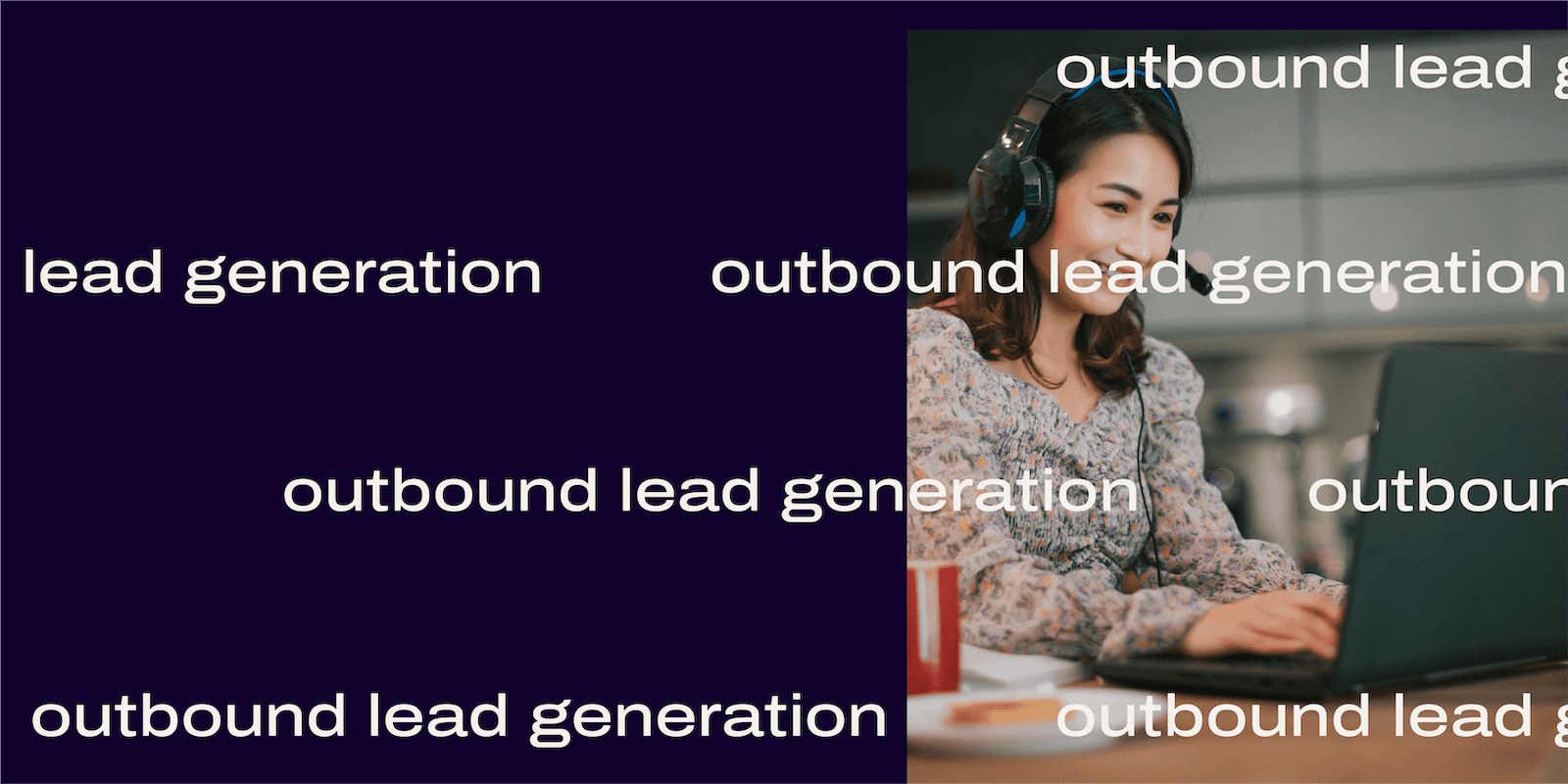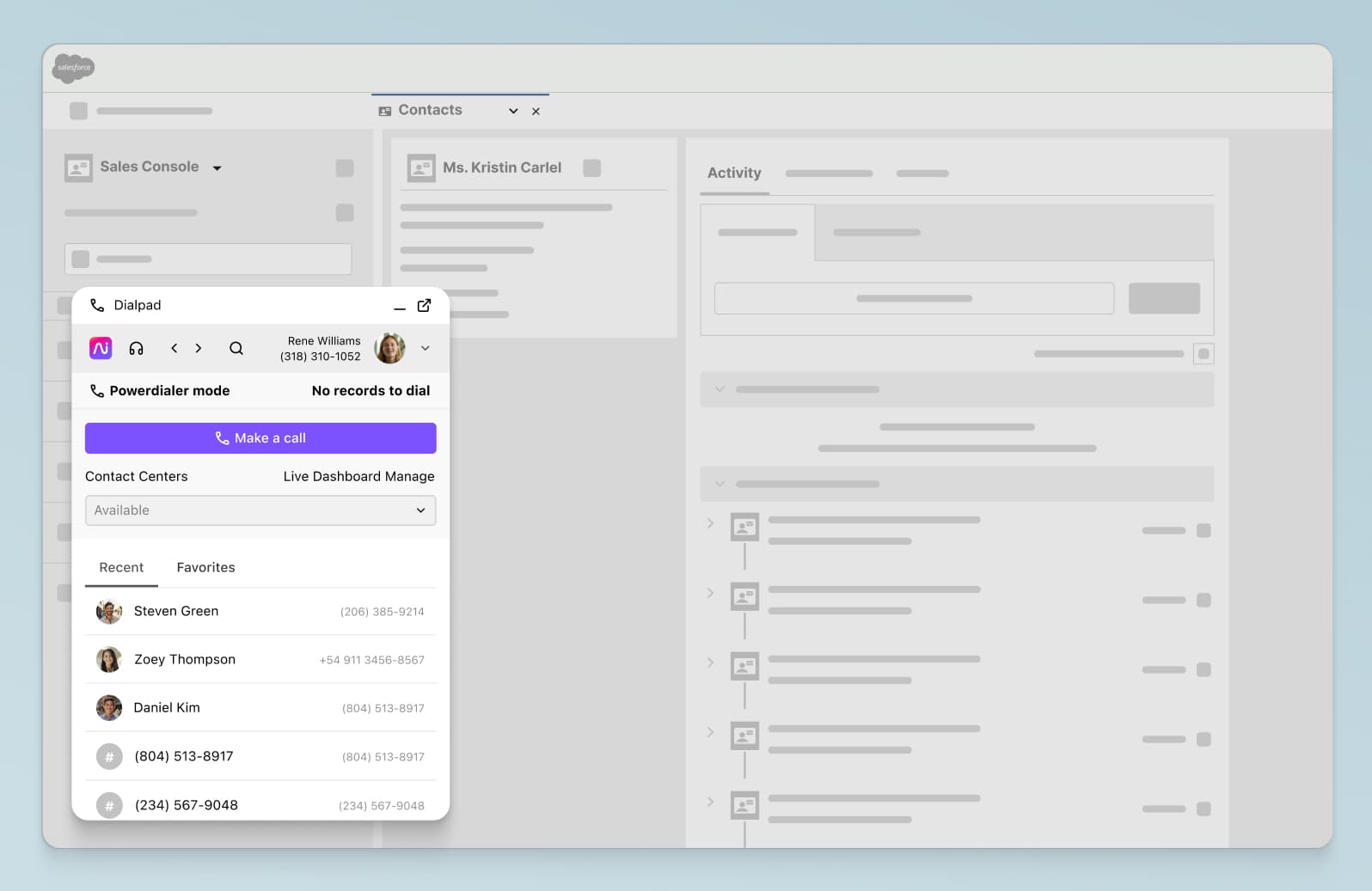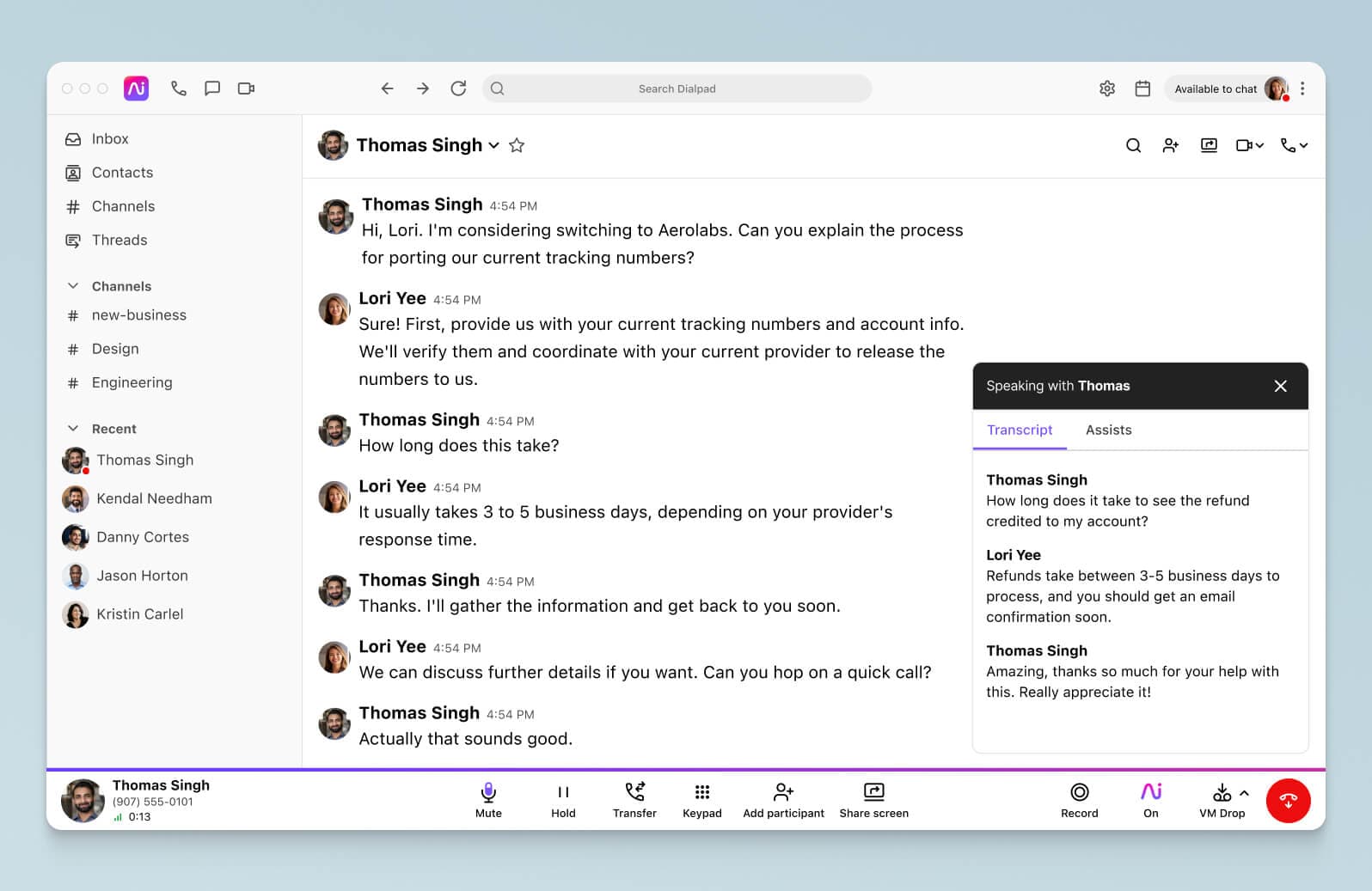What is outbound lead generation? A detailed guide

Sales Enablement Program Manager

Tags
Share
“Inbound marketing” is the buzzword on every business’s lips at the moment. Meanwhile, outbound marketing is often described negatively, and many even go so far as to say it’s outdated.
But outbound lead generation tactics can still be as effective as inbound lead generation (if not more so) when combined with an effective sales process and complementary marketing tactics.
In this blog post, we’ll look at what outbound lead generation is, how businesses often get it wrong, and a few ways to get more qualified leads.
👉 Dialpad tip:
There’s also “demand generation,” which is a different concept for another blog post. Unlike outbound lead generation, it typically falls under the responsibilities of the marketers on your team.
What is outbound lead generation?
Outbound lead generation is a method of engaging with potential customers who might not be aware of your product or service.
It involves making outbound calls or sending other communications to a target audience with the hope of generating leads. Generating leads meaning identifying and connecting with a pool of potential customers with an interest in a business’s products or services, and building a sales pipeline.
There are different communication methods and lead generation solutions businesses can use for outbound lead generation, including phone calls, email marketing, social selling, social media, TV and radio ads, direct mail, and more.
Outbound lead generation is typically done by one of two teams (or both):
Outbound marketing team (or just marketers who are doing outbound marketing)
Outbound marketing is a more traditional marketing method that pushes messages out towards potential customers (sometimes also known as outbound leads). It’s the opposite of inbound marketing, which tries to draw customers towards a business.
Outbound marketing teams facilitate this communication with various outbound marketing strategies designed to generate new leads. This team might consist of:
Campaign marketers: They run promotional campaigns through various channels including email, print, TV, radio, catalogs, and so on.
Performance marketers: These marketers and other performance marketing agencies manage paid advertising campaigns (on social media platforms or search engines) and brand marketing.
Outbound sales team
The role of an outbound sales team is to seek out potential customers using outbound lead generation strategies like reaching out via cold calling and emailing to strategically guide the prospect through the sales process towards making a purchase. Lead generation in sales typically occurs through a process of follow-up calls or emails, sales demos, negotiations, and attempts to close the sale.
The goal of the sales team is to connect with potential leads to turn them into qualified leads.
Inbound Vs. outbound lead generation
Put simply, the difference between inbound and outbound lead generation is that inbound brings leads in and outbound efforts focus on reaching out to potential leads.
Inbound lead generation efforts focus on encouraging leads to enquire about your business on their own initiative. It usually involves attracting inbound leads with websites, blogs, valuable content, or social media posts.
Inbound is a facet of digital marketing that informs people about your brand across various platforms, helping your audience to identify why they need your product or services and leading them towards the next appropriate action with landing pages and clear call-to-actions.
Inbound lead generation campaigns focus on helping your audience, rather than selling to them. Common inbound marketing methods include content marketing, SEO, social media, blogging, and lead nurturing.
These strategies attract leads to a business by providing valuable content and tailored experiences. For instance, content marketing involves distributing various types of content on your business’s website, blog, and social media channels that addresses the challenges of your audience or simply provides entertainment or educational value.
Another example is incorporating keyword research software into your content marketing strategy which enhances the inbound approach by identifying the exact terms and phrases your target audience is searching for online.
Outbound lead generation involves some way of contacting prospects directly, whether it’s through phone calls, direct mail, emails, or social channels like LinkedIn. It involves employees speaking directly to decision-makers on behalf of your business. Through targeted outreach and advertising, you can generate leads by showing prospects how your business can help them. What is the value that you’re bringing to them or their business? Why would it make sense for them to talk to you or purchase your product?
Although these two approaches seem like polar opposites, there are some similarities between the two:
The objective of both inbound and outbound lead generation is to generate quality leads (this is the top priority for 79% of marketers worldwide) and boost brand awareness
Both methods require you to segment your target audience (e.g. by industry, company size, and so on)
But, research shows that over 80% of buyers are still willing to accept calls from sellers who reach out to them.
Whether they’re in the B2C niche or are involved in lead generation for B2B, most successful businesses rely on a mixture of inbound and outbound lead gen strategies.
It’s important to understand how both approaches work and how they can help you to attract leads and secure sales.
The benefits of outbound lead generation
When implemented with the right strategies and B2C or B2B lead generation tools, outbound lead generation can be just as effective as inbound. Here are some of the main benefits of outbound lead gen for businesses:
Shortens your sales cycle: Outbound lead gen is a great way to hyper-target leads that are ready to make a purchase decision.
Build brand awareness: Outbound tactics are a great way to reach both a wide and narrow target audience to increase brand awareness and boost your visibility. For example, cold calling should be more targeted, while mass email and direct mail can be for a wider audience.
Test and reach new markets: Outbound allows you to get your business in front of new markets who might not be aware of what you have to offer. Your sales team might make hundreds of cold calls each day, with real-time analytics your team can track which methods work and which don’t.
4 Ways businesses get outbound lead generation wrong
Outbound lead generation has got kind of a bad rap over the years. Often, it’s because people have received unsolicited cold calls and emails that didn’t follow established guidelines or felt intrusive. Here are some common pitfalls marketers and sales reps encounter when it comes to outbound lead generation:
1. You haven’t identified your ideal customer profile
Before you can start effective sales prospecting, you need to understand who your ideal customers are. Buyer personas are integral to any inbound or outbound lead generation campaign, but if you haven’t identified qualified leads—those who are actively searching for the solution you offer—it’s likely not going to result in a sale.
Tools from LinkedIn and Google allow you to accurately target potential markets by providing you with insight into audience demographics and behaviours. By understanding who your ideal customers are and what stage of the buyer journey they’re at, you can reach the right people with the right message.
2. You aren’t using the right outbound lead generation tools (or you’re using them incorrectly)
There are hundreds of options when it comes to outbound lead generation software UK businesses can choose from. Most will say they can help your marketing and sales teams to work as productively as possible. From handling email outreach to email campaigns, the sheer range of sales lead generation apps is endless.
Lead generation tools should automate your processes, not hinder them. Here are a few things to look for:
Usability: Is it intuitive and user-friendly, allowing you to get your campaigns up and running efficiently?
Integration: Does it integrate with other marketing tools in your tech stack?
Pricing: Is the tool affordable for your budget and comparable in price to other tools with similar features?
Features / benefits: Does it come with all the features you need for your lead generation campaigns? (For example, if you have a high velocity sales team, does the tool help them make significantly more calls in less time?
Most outbound sales teams will need a business phone system that has all the calling features and analytics tools—ideally built in—to help them efficiently connect with prospects and guide them towards the sale.
Dialpad Ai Sales Center has everything our sales team needs. It has advanced calling features designed for communicating with prospects, like a power dialer and real-time coaching for reps:

Not only that, it also has integrations with CRM tools like Salesforce and HubSpot to keep all your customer data up to date. It also integrates with tools like Outreach to make sending out email campaigns a breeze.
3. Your marketing and sales teams are misaligned
A lack of alignment between a business’s sales and marketing teams is a major pitfall when it comes to outbound lead generation. For instance, if your marketing team generates unqualified leads that don’t meet the standards of sales teams, it likely won’t end in a sale.
That's why it's important to make sure your sales and marketing teams aren’t operating in silos. The easiest way to do this is to use a communications tool that allows teams across departments to connect and collaborate seamlessly.
We use Dialpad to stay connected with Marketing—because we can make phone calls, have video meetings, and have messaging threads, it’s easy to stay aligned, even when many of us are remote:

4. You’re not pairing it with a demand strategy
One of the biggest mistakes businesses make when it comes to lead generation is thinking that it’s the only tactic they should use to get more customers.
This is most applicable to B2B and SaaS companies, which have more complicated products. (If you’re selling a soda, feel free to skip this section.)
An outbound lead generation strategy, no matter how good it is, can be very expensive over time—and one of its biggest weaknesses is that when you stop doing outreach, the leads stop coming in. It’s better to pair your outbound strategy with an inbound demand strategy to maximize effectiveness.
A good demand generation strategy is focused on educating your market and nurturing these prospects so they have a good understanding of what your product or service actually is, and even when you “turn off” that demand strategy, you don’t lose the benefits of having run it as much—because you already did the work to educate these prospects.
On the other hand, if you’re just doing cold calls, you’re not really taking the time to educate or nurture them. It’s a very straightforward “ask if they’re interested / ready to buy, and if not, move on” approach. But the short-term benefits are greater here, because demand gen strategies typically take a much longer time to bear fruit.
The Cliffnotes version: Outbound lead gen works best if you pair it with a demand gen strategy, so that you can cover both the short term and long term.
Essential outbound lead generation strategies for growing businesses
Now you know the benefits of an effective outbound lead generation strategy, you’ll be wondering how to create and execute one. The following are some key aspects of lead generation marketing and sales teams need to nail:
Cold calls and emails
Cold calling and emailing is a hugely cost-effective outbound lead generation tactic for B2B companies. Doing this allows your marketing and sales teams to build prospect lists and effectively market to a wide audience.
However, there are some things to consider when it comes to cold email outreach.
First, you’ll need great cold calling software. Ideally, this will come as part of a holistic communications platform that gives your outbound call center all the functionality it needs
Again, the great thing about working at Dialpad is we can use our own products to sell! Dialpad Ai Sales Center is a platform built for sales, and lets our reps make more efficient cold calls with HD call quality, SMS, real-time coaching and transcriptions, and other powerful calling features in a unified sales communications platform:

So how can Dialpad help you make better cold calls?
With Dialpad, reps can make hundreds or thousands of calls a day and automatically dial the next number on the outreach list. No more manual dialling.
But that’s not the only tool you’ll need for effective cold calling. The system you choose should seamlessly integrate with your business’s Customer Relationship Management (CRM) tool to help streamline cloud contact center workflows.
Dialpad’s Salesforce integration embeds power dialer functionality right into your CRM. This way, your team doesn't have to waste time switching between windows or tabs. And the Salesforce integration is what legal practice management software company Rocket Matter liked most when they switched their business communications solution to Dialpad.
With Salesforce, Rocket Matter sales reps can track calls, coach new team members, understand caller sentiment, and view reporting to ensure high call quality and effective interactions every time.
That’s not even the coolest part about this integration, though. You can use it on any app, desktop, or mobile, as well as through your browser. Dialpad Ai can also automatically transcribe every call that takes place so your agents don’t have to manually take notes.
Dialpad Ai is hyper-accurate (even more so than almost all leading competitors), and also lets managers create Real-Time Assist (RTA) cards that pop up automatically on reps' screens with notes when certain keywords are spoken—inside Salesforce:

(Oh, and if your team doesn’t use Salesforce, Dialpad offers integrations with other CRM tools like HubSpot.)
Another cool feature Dialpad offers is call recording, which makes it easy to record calls for training and compliance.
Managers can create playlists of calls for coaching purposes—we can pick out some successful prospecting calls and make a “greatest hits” (or make playlists of calls that are good learning opportunities):

Another feature that our reps use heavily is voicemail drop. This allows reps to “drop” pre-recorded messages to a call as soon as you reach a prospect’s answering machine. This way, agents don’t have to recite the same message each time a call isn’t answered (and Dialpad’s voicemail drop is TCPA-compliant—it’s not robocalling—because the rep has to push the voicemail drop button once the call is connected):

Finally, if your team uses Outreach to manage email outreach sequences, Dialpad integrates with that, too. Track open rates and metrics to analyze your email campaign results—all without toggling back and forth between windows:

With Dialpad, our sales team has everything they need for cold calling and emailing—in one place. That means no toggling between apps or logging in and out of different platforms, which makes for a much more streamlined workflow that helps our sales reps be more productive while closing more deals.
Social selling
In B2B marketing, social selling is when sales reps connect with leads as part of the sales process to grow their brands.
Social selling typically takes place over social networks like LinkedIn, Facebook, and Twitter.
According to LinkedIn, there are four pillars of social selling:
Create a professional brand: This shows you’re a leader in your industry and leads to more inquiries and responses from prospects.
Focus on the right prospects: With social selling, you can easily find prospects that meet your established criteria—so you can reach out to the people who are more likely to be interested.
Engage with insights: Social selling allows you to position yourself as an industry leader by sharing relevant content, engaging with news alerts, and building your brand.
Build trusted relationships: Share relevant information and share your perspectives to build trust and have genuine conversations with prospects. This means focusing on what the prospect needs before selling.
PPC (Pay-Per-Click) campaign
PPC advertising campaigns are a great way to get your brand’s name out there in front of new leads. It’s outbound lead generation because viewers don’t ask to see or look for your advertisements.
These campaigns are targeted towards people who might not be aware of your brand. Pay-Per-Click is pretty self-explanatory: You’ll pay every time a user clicks on your online adverts.
Pay-Per-Click can be pretty costly for small businesses, as it requires you to pay a sum of money to a host website. This is a popular way for brands to advertise their products or services on social media or search engines like Google and Bing.
Building a winning PPC marketing campaign isn’t easy. It requires a lot of effort that goes into researching and selecting appropriate PPC keywords, to organizing and grouping those keywords into campaigns and ad groups, to creating effective landing pages optimized to convert visitors, conducting a thorough PPC audit, and more.
Note that search engines reward advertisers that create relevant and targeted PPC campaigns, rather than those who simply slap them together. So it pays to ensure your PPC campaigns are targeted towards particular audiences and the things they might be searching for. In other words, you need to make sure you’re doing PPC the right way. This is especially true if you have a local business, and you can explore local PPC management for better results.
Referrals
Referral marketing is all about incentivizing existing customers to introduce their family and friends to your company. It’s about turning your brand’s customers into brand advocates, while providing them with incentives to share information about your company. Note that there is a difference between inbound and outbound referrals.
Inbound referrals: These referrals come to you after they hear about your business from someone else. They are qualified leads who are likely to convert.
Outbound referrals: Require you to make an outgoing call to someone whose name you’ve been given. They aren’t as qualified as inbound referrals.
👉 Dialpad tip:
Another type of outbound referral is when you call a prospect and they tell you they aren’t the right person—but tells you who to speak with. This is a type of referral that many people forget about: a referral that someone at your target company gives you.
To effectively carry out word-of-mouth marketing strategies, you’ll need to contact buyers directly to gauge customer satisfaction with your brand. That’ll help you to determine which lead generation solutions have worked well and whether other aspects of your business, like customer service, are up to scratch.
With Dialpad, you can reach out to customers directly across a range of channels. Once you know a bit about their behavior, you’ll understand whether they prefer to be contacted via phone, email, social media, or another channel.
This strategy only works when your customers are satisfied with their customer experience with your brand. Using a collaboration platform like Dialpad enhances the customer experience from the get-go.
From the moment a sales representative reaches out to a customer, to when the time comes for a customer to ask for support, Dialpad has you covered with integrated communications and advanced calling features like intelligent call routing, custom IVR, and toll-free numbers to ensure every call is successful.
With 100% SLA uptime guaranteed and enterprise-grade security, Dialpad keeps all your customers happy.
If you really want to be sure of that, you can create customer satisfaction (CSAT) surveys in Dialpad to collect that data:

Ready to grow your business with outbound lead generation?
With the right outbound lead generation strategies, you can quickly grow your leads to reach a wider audience and increase sales. Implementing the right sales communications technology makes this much easier for your sales teams.
Empowering your team with a platform with built-in AI and sales tools like Dialpad Ai Sales Center is a great place to start. (Learn more about sales AI here.)
Make more calls every day with Dialpad’s power dialer, integrate the platform with your CRM to automate contact data entry, and keep customers happy at every stage of the customer journey with omnichannel support. All of this at any time, on any device.
Ready to see how we can help you with outbound lead generation? Take Dialpad for a test drive with a 14-day free trial.
Help your team with outbound lead generation and reach more prospects
Looking for a tool to help your team with outbound lead generation and reach more prospects? Book a product tour of Dialpad Ai Sales Center to see how it can work for your reps!









